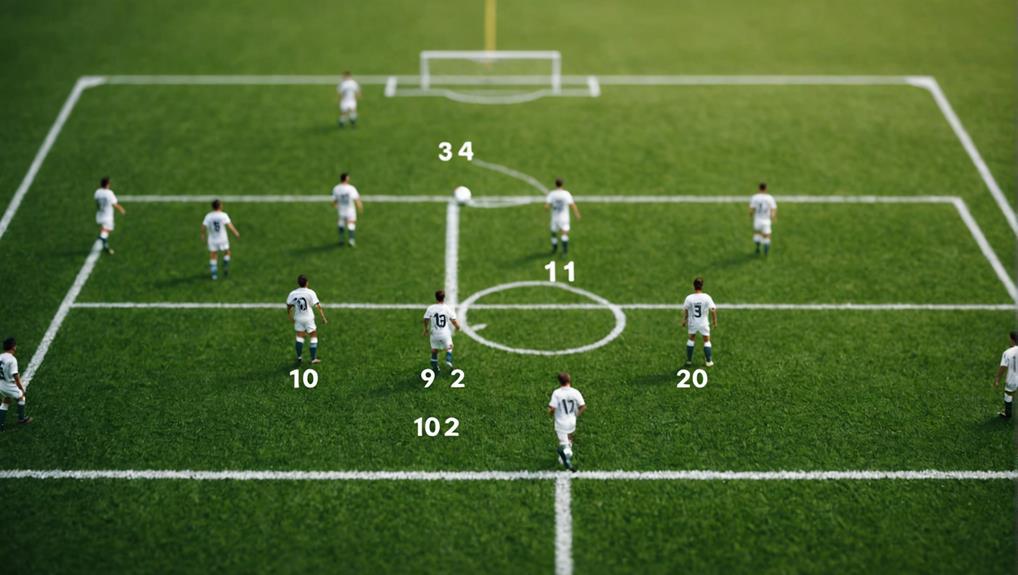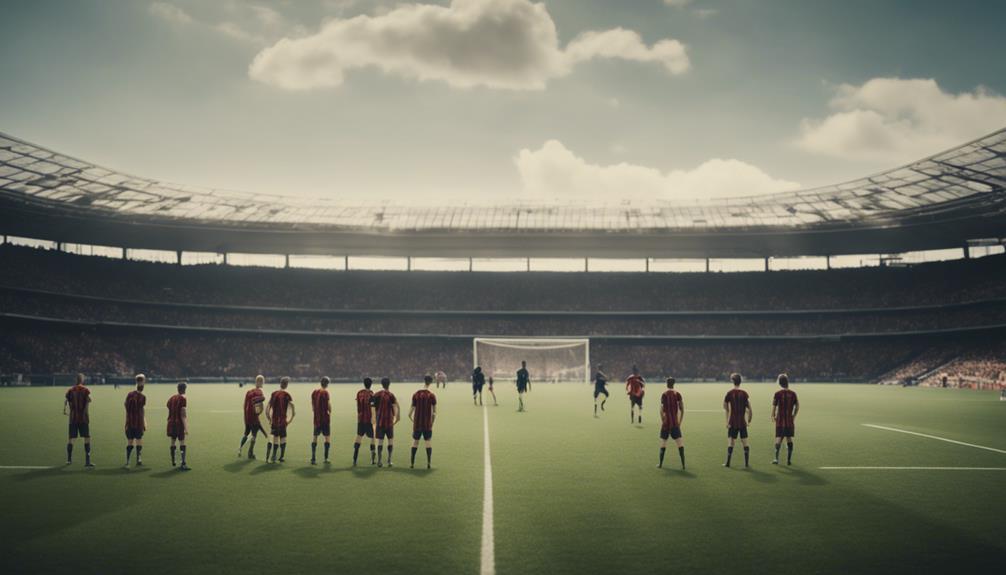
Best Soccer Formations for Winning Matches: Top 10 Picks
April 25, 2024When you seek to win matches, consider these top 10 soccer formations: the 4-4-2 Classic, 4-5-1 Park the Bus, and the 4-3-3 Counter Attacker. The 4-4-2 Diamond, 3-5-2 Defensive Organization, and 3-4-3 Attacking Formation are also great options. Don't forget the 4-1-2-1-2 Midfield Diamond, 4-4-1-1 Tactical Setup, and the 4-2-3-1 Versatile Formation. Each formation has its strengths and strategies that can boost your chances of success on the pitch.
4-4-2 Classic Formation
When utilizing the 4-4-2 classic formation in soccer, striking a balance between defense and offense is key to achieving success on the field. The 4-4-2 formation, with its 4 defenders, 4 midfielders, and 2 strikers, provides a foundation of defensive stability while also offering opportunities for attacking play. Strategic player selections play an important role in optimizing the team's performance within this formation. It's essential to choose players who can maintain the team's balance by fulfilling both offensive and defensive duties effectively.
In the 4-4-2 formation, defensive stability is a cornerstone of its success. The four defenders create a solid backline that's hard to penetrate, while the midfielders support both defensively and in guiding the team to attack. The two strikers up front provide the necessary firepower to capitalize on offensive opportunities. Therefore, selecting players who understand their roles within this formation is crucial for maintaining its effectiveness on the pitch.
4-5-1 Park the Bus
Incorporating the 'Park the Bus' formation into your tactical approach can greatly influence the dynamics of your team's defensive strategy. This defensive strategy focuses on midfield superiority, aiming to create a crowded midfield by deploying 5 midfielders. To make this strategy effective, you need a mix of defensive midfielders for stability and offensive-minded midfielders for changes. However, one challenge of this formation is generating scoring opportunities in the final third due to its defensive emphasis.
Here are some key points to think about when implementing the 'Park the Bus' formation:
- Utilize defensive midfielders strategically to shield the defense and disrupt opponent attacks.
- Maintain midfield superiority by compacting the midfield to limit the opponent's passing lanes.
- Adjust your defensive strategy based on the flow of the game to remain resilient in the face of pressure.
- Be prepared to capitalize on counter-attacking opportunities to create scoring chances despite the defensive focus.
4-3-3 Counter Attacker

When setting up your team in a –3 Counter Attacker formation, focus on exploiting your players' speed during attacking shifts.
Guarantee your defensive line remains solid to thwart any counterattacks from the opposition.
Utilize the wide attacking options available to stretch the opponent's defense and create scoring opportunities.
Speedy Attacking Transitions
To execute speedy attacking maneuvers in the Counter Attacker formation, prioritize utilizing fast wingers and a lone striker for quick offensive tactics.
When focusing on speedy attacking switches in a 4-3-3 formation, consider the following key points:
- Exploit the Wings: Utilize the pace of your fast wingers to stretch the opponent's defense wide and create opportunities for quick counter-attacks.
- Quick Change: Make sure your lone striker is ready to make rapid runs behind the defense to capitalize on the fast breaks initiated by the wingers.
- Midfield Support: Have supportive midfielders who can quickly distribute the ball to the wingers and striker to maintain the tempo of the attack.
- Capitalizing on Space: Train your players to identify and exploit gaps in the opponent's defense during fast-paced switches to create scoring chances efficiently.
Defensive Solidity When Countered
For enhanced defensive solidity when countered in the Counter Attacker formation, focus on maintaining compactness and swift defensive shifts.
In this setup, the defensive line needs to stay organized to prevent quick opposition counter-attacks. Midfielders play a pivotal role in tracking back to support the defense during changes from attack to defense.
Effective communication and coordination among defenders and midfielders are key to thwarting counter-attacking threats. Quick decision-making is essential to anticipate and neutralize any fast breaks by the opposition.
Wide Attacking Options
Utilizing pacey wingers and a lone striker, the wide attacking options in the -3 Counter Attacker formation emphasize quick counter-attacks.
To make the most of this strategy, consider the following:
- Exploiting Spaces: Use the speed of your wingers to exploit any gaps left by the opposition's defense.
- Stretching the Defense: Encourage your lone striker to make runs that stretch the opposing defense, creating room for the wingers to exploit.
- Incisive Movements: Train your forwards to make sharp, decisive movements to break through the defense quickly.
- Midfield Support: Make sure your midfielders are adept at providing accurate passes to feed the attackers and maintain possession during fast breaks.
4-4-2 Diamond

In soccer, the 4-4-2 Diamond formation demands a strong anchor midfielder to dictate play and disrupt the opposition. This player is important in maintaining defensive solidarity and initiating attacks from the center of the pitch.
The 4-4-2 Diamond's narrow structure presents challenges in creating space and opportunities in the opponent's half. It requires intricate passing and movement to break down defenses effectively. To succeed with this formation, finding the right balance between defensive stability and offensive creativity is essential.
Teams need to make sure that the anchor midfielder not only shields the defense but also links up play with the forwards. Defensive solidarity is key in the 4-4-2 Diamond, as the narrow formation can expose full-backs to counterattacks.
As such, effective communication and positioning are crucial to prevent the opposition from exploiting the wide areas. Mastering the intricacies of this formation can lead to a well-rounded and competitive team on the field.
3-5-2 Defensive Organization
You need to understand the critical roles of wing-backs and the dynamics within the midfield triangle to excel in defensive organization in the 3-5-2 formation.
The effectiveness of your defensive line hinges on how well you utilize the wing-backs to provide cover while maintaining a balance in the midfield.
Coordination and communication among defenders and midfielders are essential for a solid defensive structure in the 3-5-2 setup.
Wing-back Roles Importance
Playing an important role in both defense and attack, wing-backs are essential components of the 3-5-2 formation, providing width and support on the flanks. In this system, wing-backs are critical for the team's success due to their versatility and ability to contribute effectively in both phases of the game. Here are some key points to keep in mind regarding the significance of wing-back roles in soccer:
- Wing-backs cover the flanks, supporting defensively and offensively.
- They need to be versatile players with strong defensive skills and pace.
- Overlapping with midfielders or forwards is a common tactic used by wing-backs.
- Coordination with central defenders is crucial for maintaining defensive organization in the 3-5-2 system.
Midfield Triangle Dynamics
Coordinating effectively between the midfield triangle players is fundamental for maintaining defensive organization in the 4-2-3-1 formation. The two holding midfielders serve as a shield for the defense, breaking up opposition attacks and providing cover for the backline. Simultaneously, the attacking midfielder bridges the gap between defense and attack, orchestrating plays and creating goal-scoring opportunities.
This strategic setup not only guarantees defensive stability but also allows for a smooth shift from defense to offense. The midfield triangle's cohesive play is vital for controlling the center of the pitch, dominating possession, and setting the tempo of the game. Effective communication and understanding among these players are paramount for the team's overall success in implementing this formation.
4-2-2-2 Balanced Approach

Incorporating a balanced approach in soccer formations can greatly enhance a team's performance on the field. The 4-2-2-2 formation provides a structured yet flexible setup that allows for versatile player roles, creative attacking options, and defensive stability.
Here are some key aspects to ponder when utilizing this formation:
- Fluid Structure: The 4-2-2-2 formation offers a balanced distribution of players across the field, allowing for seamless shifts between defense and attack.
- Versatile Player Roles: Dynamic wingers, attacking full-backs, and a midfield duo of a destroyer and a playmaker are essential components of this formation, enabling players to adapt to different scenarios effectively.
- Creative Attacking Options: Teams like AC Milan have capitalized on the creative attacking opportunities presented by the 4-2-2-2 formation, leading to successful offensive plays and goal-scoring chances.
- Defensive Stability: Emphasizing teamwork and strategic positioning, this formation prioritizes defensive solidity while still providing a platform for offensive creativity and goal-scoring potential.
3-4-3 Attacking Formation
When adopting the 3 attacking formation, you'll embrace a forward-oriented attacking style that seeks to apply continuous pressure on the opposition's defense.
Dominating the midfield becomes vital in maintaining possession and facilitating smooth shifts between defense and attack.
Forward-Oriented Attacking Style
In the -3 attacking formation, the emphasis is on prioritizing forward-oriented attacking play with a strong focus on offensive pressure. This formation thrives on creating goal-scoring opportunities through the following key elements:
- Three Forwards: Having three forwards upfront increases the attacking threat and puts pressure on the opposition's defense.
- Offensive Pressure: Teams using this formation constantly press high up the pitch to force turnovers and capitalize on attacking chances.
- Numerical Superiority: By committing more players forward, the team aims to outnumber the opponent in pivotal areas, creating overloads and space.
- Goal-Scoring Opportunities: The main objective is to create as many chances as possible by playing with an aggressive and forward-thinking mindset.
Midfield Dominance Crucial
Ensuring midfield dominance is pivotal in the success of a 4-3-3 attacking formation. It dictates the flow of play and creates scoring opportunities. The three central midfielders in this setup play a vital role in maintaining possession football, controlling the tempo, and linking up play between defense and attack.
By outnumbering the opposition in the middle of the pitch, teams can establish control, win possession, and launch quick attacks with precision. The 4-3-3 formation allows for intricate passing triangles and dynamic movement, enabling fluid progress from defense to attack through the midfield.
Teams utilizing this strategy aim to overwhelm opponents in the central areas, press high up the pitch, and exploit gaps in the defensive line by dominating the midfield battle.
Defensive Stability Essential
To maintain a solid defensive foundation in a -3 attacking formation, focus on disciplined defending and organized positioning to thwart opponent attacks. Here are some key aspects to ponder when aiming for defensive stability in this formation:
- Maintain a compact shape: Guarantee your defensive line stays close to prevent gaps that opponents can exploit.
- Swift switch to defense: Train your players to switch from attacking to defending rapidly to catch opponents off guard.
- Communication is key: Foster constant communication among defenders to coordinate movements and mark opponents effectively.
- Stay patient and composed: Avoid rushing into tackles or making hasty decisions, instead, stay calm and wait for the right moment to regain possession.
4-1-2-1-2 Midfield Diamond
Maximize your team's midfield control and strategic flexibility with the dynamic 2-1-2 Midfield Diamond formation.
This setup includes two central midfielders who excel at dictating play and distributing the ball, a defensive midfielder who provides a shield to the backline while also initiating attacks, and two attacking midfielders who are pivotal in creating scoring opportunities.
The midfield diamond shape offers a compact and organized structure that allows your team to dominate the center of the field efficiently.
With players positioned strategically, passing options are plentiful, enabling smooth shifts and maintaining possession effectively.
By using the 2-1-2 Midfield Diamond, you can gain numerical superiority in midfield battles and exploit gaps between the opposition's lines.
This formation not only provides defensive solidity but also encourages attacking creativity through fluid ball circulation and support. Embrace the 2-1-2 Midfield Diamond to strengthen your team's presence in the midfield and enhance your overall performance on the pitch.
4-4-1-1 Tactical Setup

When implementing the 1-1 Tactical Setup, focus on creating numerical superiority in key areas of the pitch. This formation emphasizes defensive solidity and strategic positioning to control the game effectively.
Here are some key points to keep in mind when utilizing the 1-1 Tactical Setup:
- Utilize central midfielders: Central midfielders play a vital role in this formation, serving as the link between defense and attack.
- Maintain defensive shape: Emphasize the importance of maintaining two banks of four to provide stability at the back and limit the opponent's attacking opportunities.
- Exploit numerical advantages: Look for opportunities to overload specific areas of the pitch to outnumber and outmaneuver the opposition.
- Quick conversions: Encourage quick conversions from defense to attack to catch the opponent off guard and create scoring opportunities.
4-2-3-1 Versatile Formation
Featuring three defenders, one defensive midfielder, and six attacking players, the 3-1 Versatile Formation offers a strategic balance between defensive stability and offensive prowess on the pitch.
This formation provides a unique blend of defensive resilience and attacking flair, making it a strategic choice for teams looking to control the midfield and create goal-scoring opportunities.
The pivotal midfielder plays a vital role in this setup, acting as a shield for the defensive line while also contributing to the team's build-up play from the back.
With six attacking players, the 3-1 Versatile Formation allows for flexibility in offensive movements and creates numerical advantages in key areas of the field.
This flexibility enables teams to adapt their playing style based on the opposition, making it a versatile option for coaches aiming to secure victories.
Conclusion
So there you have it, the top 10 soccer formations for winning matches. Remember, the key is to play to your team's strengths and adapt to your opponent's weaknesses.
As they say, 'don't put all your eggs in one basket.' Experiment with these formations, find what works best for your players, and always stay one step ahead of the competition.
Good luck out on the field!


